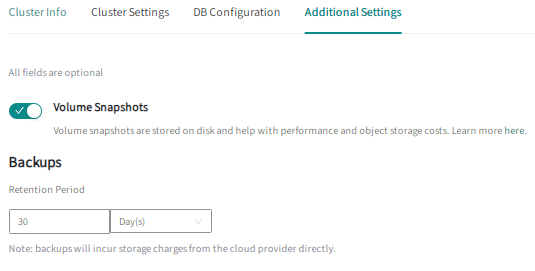
Enhancing performance, observability, stability, and security of the unified EDB Postgres AI platform
This blog was co-authored by David Wagoner, Simon Notley, and Tim Boutin.
As part of strategic planning leading to the EDB Postgres® AI announcement, our Product Management and R&D teams established a quarterly release cadence to drive the innovations that provide the foundation of this unified transactional, analytical, and AI workloads platform.
Today’s EDB Postgres AI Cloud Service roadmap announcement extends features delivered in the initial EDB Postgres AI Q2 Release with upgrades that:
- Enhance EDB Postgres AI platform stability and performance with an operating system (OS) upgrade to Debian 12
- Expand observability into Session Wait States and Health Status
- Deliver EDB Postgres AI Cloud Service snapshot backup and recovery capabilities
- Bolster the security of cloud resources by enhancing customer-managed Transparent Data Encryption (TDE) options
- Boost performance of read-heavy applications
Let’s take a closer view at how our Q2 EDB Postgres AI Cloud Service release enhances performance of Postgres databases running in multi-cloud data infrastructures.
Enhancing platform stability with automatic EDB Postgres AI Cloud Service OS upgrade for Debian 12
In advance of Debian 10 reaching end of support on June 30th, we are enhancing performance, improving security, and providing closer compatibility with modern Postgres version libraries by delivering an automatic EDB Postgres AI operating system (OS) platform upgrade to Debian 12.
With this release, we have eliminated the need for user actions required to facilitate this OS update by automating and managing the image upgrade from Debian 10 to 12 through the EDB Postgres AI Cloud Service. Optionally, users can elect a weekly maintenance window that will enable the upgrade to be performed during the specified timeframe. Alternatively, an end-of-month maintenance cycle can be employed for the OS upgrade.
Expanding observability into Session Wait States and Health Status
In Q2, we are complementing EDB Postgres AI Cloud Service Observability capabilities to include new analytics into EDB Wait States and Health Status.
Powered by the EDB Wait States extension, the new Session Wait States metrics provide insight into how active session time is spent. Are sessions waiting on IO or locks, for example. This is the first step toward a much more sophisticated query analysis capability that will allow developers and DBAs to drill into and understand the database workload by query, user, and session.
We’re also adding new metrics and visualizations to help operators understand the health, operational state, and topology of EDB Postgres Distributed clusters running on the EDB Postgres AI Cloud Service. With the Health Status View, operators can view all the nodes in primary/standby and EDB Postgres Distributed clusters, how they are connected, and what role each is currently playing. Operators can access an at-a-glance single-page view to analyze the health of each node in the cluster, connections between them, as well as the cluster as a whole. By accessing this new capability, operators can reduce the potential of downtime by pinpointing issues before they happen, leveraging immediate visibility of key operational information such as which nodes are the write leaders, how many clients are connected, and how much replication lag exists between nodes within and across locations.
Automating Postgres cloud database snapshot backup and recovery processes
Customers can now automatically backup and restore their EDB Postgres AI Cloud Service data more efficiently than ever, with our Q2 release automating volume snapshot backup and recovery for single-region environments, including those using EDB Postgres Distributed clusters. Regardless of database size, EDB Postgres AI Cloud Service Volume Snapshot Backups enable customers to keep their systems backed up without associated downtime and reduced performance tradeoffs.
As a result, backup and recovery times move from hours to minutes, supporting organizational RTO targets when recovering from a backup, including point-in-time recovery.
Enterprises will benefit from a lower performance impact of snapshot backups, as compared to base backups, with EDB Postgres Cloud AI Service leveraging high-performance disks, such as Azure Ultra Disks, AWS io2, and GCP with Performance (SSD) persistent disks. As a result, the database remains fully available while a backup is in progress, as EDB Postgres AI Cloud Service snapshot backups are virtually undetectable.
Operators can quickly switch the default daily backup method to snapshots, from base backups, using the EDB Postgres AI Cloud Service interface.

Once enabled, automating snapshot backup and recovery becomes the default configuration, replacing base backup.
Expanding EDB TDE support in AWS, Google Cloud, and Azure multi-cloud data infrastructures
In Q1, the EDB Postgres AI Cloud Service raised the bar for Postgres database security and compliance by delivering transparent data encryption (TDE), normally only available for commercial databases such as Oracle and SQL Server. In the process, EDB helped customers meet organizational security requirements by providing control over data encryption at rest by delivering customer-managed TDE in the cloud. EDB’s delivery of TDE includes key management external to Postgres, with initial support for AWS Key Management Service announced in Q1.
With our Q2 release, customers can now employ Transparent Data Encryption on EDB Postgres Cloud AI Service deployments running on a customer’s Amazon Web Services, Google Cloud, or Microsoft Azure cloud infrastructures (operating in a “bring your own account” model), as well as EDB’s fully hosted DBaaS deployments. The EDB Postgres AI Cloud Service supports keys residing in AWS KMS, Google Cloud KMS, and Azure Key Vault.
Once a user creates a cluster with TDE enabled, the EDB Postgres AI Cloud Service automatically encrypts the cluster at rest as well as its backups and faraway replicas with an encryption key the user provides.
Improving performance of read-heavy applications in the cloud
In further refining customer options to improve performance of read-heavy applications running in multi-cloud data infrastructures, EDB has added the ability to expose read-only endpoints for shadow nodes in EDB Postgres Distributed clusters running in the EDB Postgres Cloud AI Service.
This feature enhances the current ability for the EDB Postgres AI Cloud Service to use read-only connection strings for high availability clusters, which enables customers to optionally perform read-only operations to connect to one of the standby replicas. As a result, the EDB Postgres AI Cloud Service offloads some of the read traffic from the primary node of the cluster to focus on write traffic. With the Q2 release, customers can now offload read queries to the non-lead (aka shadow nodes) on their EDB Postgres Distributed clusters to lighten the workload on the lead node. Users can enable this option when creating or editing a cluster.
Developers can use this EDB Postgres AI Cloud Service enhancement to improve read-heavy app performance in their organizational AWS, Google Cloud, and Azure cloud environments, as well as EDB’s fully hosted DBaaS deployments.
Q2 EDB Postgres AI feature enhancements summary
EDB Postgres AI is our intelligent platform for transactional, analytical, and AI workloads managed across hybrid and multi-cloud environments. It can be deployed in the EDB Postgres AI Cloud Service featured in this blog or as software. The EDB Postgres AI platform offers built-in observability, AI-driven assistance, and a single pane of glass for managing hybrid data estates.
We are understandably excited about what we delivered in Q2 and the continued innovation we’re providing across our second-half initiatives.
You can check out the features described in this blog by starting your free EDB Postgres AI Cloud Service trial—today!
